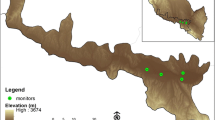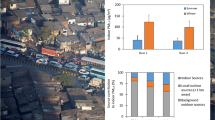Abstract
The health impact of atmospheric pollution is one of the hot topics in current environmental research. Herein, we examined the impacts of indoor and outdoor air pollution on respiratory health across three distinct communities in Xi’an, China. By employing a mixed-methods approach, this research quantitatively assessed particulate matter concentrations alongside gases such as CO, CO2, NO, and NO2, contrasting indoor and outdoor environments. The indoor and outdoor pollutants of urban communities presented higher emission levels, the disparities in indoor pollutant concentrations across the communities were primarily attributed to domestic activities including cooking, incense burning, and smoking. Notably, CO and CO2 levels were elevated indoors, underscoring the influence of human activities and inadequate ventilation on indoor air quality. The higher indoor/outdoor (I/O) pollutant ratios of CO and NO pointed to predominant indoor sources of these pollutants; additionally, the suburban community showed higher I/O ratio. Through lung function assessments, a negative correlation between air pollutant concentrations and respiratory health outcomes among residents was established, demonstrating the detrimental effects of air pollution on pulmonary health. The findings underscored the critical public health implications of air pollution, advocating for comprehensive interventions to enhance air quality and mitigate the adverse health impacts of pollution in residential settings.




Similar content being viewed by others
References
Akther T, Ahmed M, Shohel M, Ferdousi FK, Salam A (2019) Particulate matters and gaseous pollutants in indoor environment and association of ultra-fine particulate matters (PM1) with lung function. Environ Sci Pollut Res 26:5475–5484
Arbex MA, Martins LC, Pereira LAA, Negrini F, Cardoso AA, Melchert WR, Arbex R, Saldiva PHN, Zanobetti A, Braga ALF (2007) Indoor NO2 air pollution and lung function of professional cooks. Braz J Med Biol Res 40:527–534
Ayuni N, Juliana J (2014) Exposure to PM10 and NO2 and association with respiratory health among primary school children living near petrochemical industry area at Kertih, Terengganu. J Med Bioeng 3
Bernstein JA, Alexis N, Bacchus H, Bernstein IL, Fritz P, Horner E, Li N, Mason S, Nel A, Oullette J, Reijula K, Reponen T, Seltzer J, Smith A, Tarlo SM (2008) The health effects of nonindustrial indoor air pollution. J Allergy Clin Immunol 121:585–591
Bozkurt Z, Doğan G, Arslanbaş D, Pekey B, Pekey H, Dumanoğlu Y, Bayram A, Tuncel G (2015) Determination of the personal, indoor and outdoor exposure levels of inorganic gaseous pollutants in different microenvironments in an industrial city. Environ Monit Assess 187:590
Bralewska K, Rogula-Kozłowska W, Bralewski A (2022) Indoor air quality in sports center: Assessment of gaseous pollutants. Build Environ 208:108589
Branco PT, Alvim-Ferraz M, Martins FG, Sousa S (2014) The microenvironmental modelling approach to assess children’s exposure to air pollution–a review. Environ Res 135:317–332
Branco PTBS, Nunes RAO, Alvim-Ferraz MCM, Martins FG, Sousa SIV (2015) Children’s exposure to indoor air in urban nurseries – part II: gaseous pollutants’ assessment. Environ Res 142:662–670
Demirel G, Özden Ö, Döğeroğlu T, Gaga EO (2014) Personal exposure of primary school children to BTEX, NO2 and ozone in Eskişehir, Turkey: relationship with indoor/outdoor concentrations and risk assessment. Sci Total Environ 473:537–548
Jovanović M, Vučićević B, Turanjanin V, Živković M, Spasojević V (2014) Investigation of indoor and outdoor air quality of the classrooms at a school in Serbia. Energy 77:42–48
Kozielska B, Mainka A, Żak M, Kaleta D, Mucha W (2020) Indoor air quality in residential buildings in Upper Silesia, Poland. Build Environ 177:106914
Kulshreshtha P, Khare M (2011) Indoor exploratory analysis of gaseous pollutants and respirable particulate matter at residential homes of Delhi, India. Atmos Pollut Res 2:337–350
Kurmi OP, Semple S, Simkhada P, Smith WCS, Ayres JG (2010) COPD and chronic bronchitis risk of indoor air pollution from solid fuel: a systematic review and meta-analysis. Thorax 65:221–228
Lee SC, Chan LY, Chiu MY (1999) Indoor and outdoor air quality investigation at 14 public places in Hong Kong. Environ Int 25:0–450
Lin L-Y, Chuang H-C, Liu I-J, Chen H-W, Chuang K-J (2013) Reducing indoor air pollution by air conditioning is associated with improvements in cardiovascular health among the general population. Sci Total Environ 463:176–181
Luis CF, Ramón FA, Francisco Javier G-B, José Antonio RP (2013) Indoor air contaminants and their impact on respiratory pathologies. Archivos de bronconeumologia 2013年49卷1期, pp 22–27
Malerba M, Radaeli A, Olivini A, Damiani G, Ragnoli B, Sorbello V, Ricciardolo FL (2016) Association of FEF25-75% impairment with bronchial hyperresponsiveness and airway inflammation in subjects with asthma-like symptoms. Respiration 91:206–214
Mannan M, Al-Ghamdi SG (2021) Indoor air quality in buildings: a comprehensive review on the factors influencing air pollution in residential and commercial structure. Int J Environ Res Public Health 18:3276
Marchetti S, Longhin E, Bengalli R, Avino P, Stabile L, Buonanno G, Colombo A, Camatini M, Mantecca P (2019) In vitro lung toxicity of indoor PM10 from a stove fueled with different biomasses. Sci Total Environ 649:1422–1433
Mishra A, Ugra D, Kumar U (2020) Study of spirometry parameters in suspected asthmatic children in a tertiary care hospital. Int J Contemp Pediatr 7:1023
Moran-Mendoza O, Pérez-Padilla J, Salazar-Flores M, Vazquez-Alfaro F (2008) Wood smoke-associated lung disease: a clinical, functional, radiological and pathological description. Int J Tuberc Lung Dis 12:1092–1098
Morawska L, He C, Johnson G, Guo H, Uhde E, Ayoko G (2009) Ultrafine particles in indoor air of a school: possible role of secondary organic aerosols. Environ Sci Technol 43:9103–9109
Morawska L, Ayoko G, Bae G, Buonanno G, Chao C, Clifford S, Fu SC, Hänninen O, He C, Isaxon C (2017) Airborne particles in indoor environment of homes, schools, offices and aged care facilities: the main routes of exposure. Environ Int 108:75–83
Niu X, Cao J, Shen Z, Ho SSH, Tie X, Zhao S, Xu H, Zhang T, Huang R (2016) PM2.5 from the Guanzhong Plain: Chemical composition and implications for emission reductions. Atmos Environ 147:458–469
Niu X, Ho KF, Chuang H-C, Sun J, Huang Y, Hu T, Xu H, Duan J, Lui KH, Cao J (2019a) Comparison of cytotoxicity induced by PM2. 5-bound polycyclic aromatic compounds from different environments in Xi’an. China Atmos Environ 216:116929
Niu X, Ho KF, Hu T, Sun J, Duan J, Huang Y, Lui KH, Cao J (2019b) Characterization of chemical components and cytotoxicity effects of indoor and outdoor fine particulate matter (PM 2.5) in Xi’an, China. Environ Sci Pollut Res 26:31913–31923
Niu X, Jones T, BéruBé K, Chuang H-C, Sun J, Ho KF (2021) The oxidative capacity of indoor source combustion derived particulate matter and resulting respiratory toxicity. Sci Total Environ 767:144391
Nunes RAO, Branco PTBS, Alvim-Ferraz MCM, Martins FG, Sousa SIV (2016) Gaseous pollutants on rural and urban nursery schools in Northern Portugal. Environ Pollut 208:2–15
Pacitto A, Stabile L, Scungio M, Rizza V, Buonanno G (2018) Characterization of airborne particles emitted by an electrically heated tobacco smoking system. Environ Pollut 240:248–254
Pacitto A, Amato F, Moreno T, Pandolfi M, Fonseca A, Mazaheri M, Stabile L, Buonanno G, Querol X (2020) Effect of ventilation strategies and air purifiers on the children’s exposure to airborne particles and gaseous pollutants in school gyms. Sci Total Environ 712:135673
Paleologos KE, Selim MY, Mohamed A-MO (2021) Indoor air quality: pollutants, health effects, and regulations, Pollution assessment for sustainable practices in applied sciences and engineering. Elsevier, pp 405–489
Qin R, An J, Xie J, Huang R, Xie Y, He L, Xv H, Qian G, Li J (2021) FEF25-75% is a more sensitive measure reflecting Airway Dysfunction in patients with asthma: a comparison study using FEF25-75% and FEV1%. J Allergy Clin Immunology: Pract 9:3649–3659e3646
Satish U, Mendell MJ, Shekhar K, Hotchi T, Fisk WBJ (2012) Is CO2 an indoor pollutant? Direct effects of low-to-moderate CO2 concentrations on human decision-making performance. Environ Health Perspect 120:1671–1677
Shen ML, Xing J, Ji QP, Li ZH, Wang YH, Zhao HW, Wang QR, Wang T, Yu LW, Zhang XC, Sun YX, Zhang ZH, Niu Y, Wang HQ, Chen W, Dai YF, Su WG, Duan HW (2018) Declining pulmonary function in populations with long-term exposure to Polycyclic Aromatic hydrocarbons-enriched PM2.5. Environ Sci Technol 52:6610–6616
Shikha, Rajouriya K, Pipal AS, Taneja A (2023) Chemical Characterization and Health Risk Assessment of Particulate Matter Near National Highway at Urban and semi-urban locations of Northern India. Aerosol Sci Eng 7:517–533
Stabile L, Scungio M, Buonanno G, Arpino F, Ficco G (2017) Airborne particle emission of a commercial 3D printer: the effect of filament material and printing temperature. Indoor Air 27:398–408
Tran VV, Park D, Lee Y-C (2020) Indoor air pollution, related human diseases, and recent trends in the control and improvement of indoor air quality. Int J Environ Res Public Health 17:2927
Tsai W-T (2019) An overview of health hazards of volatile organic compounds regulated as indoor air pollutants. Rev Environ Health 34:81–89
Uzoigwe JC, Prum T, Bresnahan E, Garelnabi M (2013) The emerging role of outdoor and indoor air pollution in cardiovascular disease. North Am J Med Sci 5:445
Vardoulakis S, Giagloglou E, Steinle S, Davis A, Sleeuwenhoek A, Galea KS, Dixon K, Crawford JO (2020) Indoor exposure to selected air pollutants in the home environment: a systematic review. Int J Environ Res Public Health 17:8972
Wang J, Smedje G, Nordquist T, Norbäck D (2015) Personal and demographic factors and change of subjective indoor air quality reported by school children in relation to exposure at Swedish schools: a 2-year longitudinal study. Sci Total Environ 508:288–296
Weinmayr G, Romeo E, De Sario M, Weiland SK, Forastiere F (2010) Short-term effects of PM10 and NO2 on respiratory health among children with asthma or asthma-like symptoms: a systematic review and meta-analysis. Environ Health Perspect 118:449–457
Wichmann J, Lind T, Nilsson MAM, Bellander T (2010) PM2.5, soot and NO2 indoor–outdoor relationships at homes, pre-schools and schools in Stockholm. Swed Atmos Environ 44:4536–4544
Acknowledgements
This research was supported by the National Natural Science Foundation of China (42207117), China Postdoctoral Science Foundation (2021M702589), Natural Science Foundation of Shaanxi Province (2024JC-ZDXM-20).
Author information
Authors and Affiliations
Corresponding author
Ethics declarations
Competing Interests
The authors declare that they have no known competing financial interests or personal relationships that could have appeared to influence the work reported in this paper.
Electronic Supplementary Material
Below is the link to the electronic supplementary material.
Rights and permissions
Springer Nature or its licensor (e.g. a society or other partner) holds exclusive rights to this article under a publishing agreement with the author(s) or other rightsholder(s); author self-archiving of the accepted manuscript version of this article is solely governed by the terms of such publishing agreement and applicable law.
About this article
Cite this article
Niu, X., Yan, C., Tian, X. et al. Household Air Pollution in Three Urban Function Areas and Related Respiratory Health Effects. Aerosol Sci Eng (2024). https://doi.org/10.1007/s41810-024-00227-7
Received:
Revised:
Accepted:
Published:
DOI: https://doi.org/10.1007/s41810-024-00227-7




